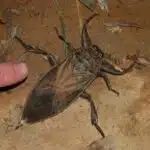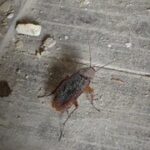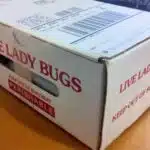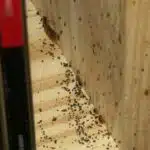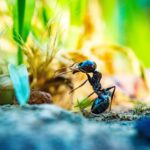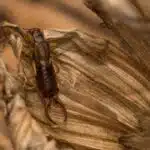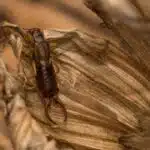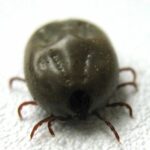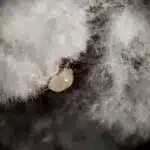June bugs, also known as June beetles or May beetles, are a common insect species found in North America. These beetles usually appear during the late spring and early summer months and are known for their distinctive buzzing sound, which can be heard from a distance. While June bugs are not harmful to humans, they can be a nuisance when they invade homes and gardens in large numbers.
As an entomologist, I have studied the behavior of many insect species, including June bugs. In this article, I will share with you five easy methods to get rid of these pesky insects. Whether you’re dealing with a small infestation or a large one, these methods are effective and safe for both humans and the environment. By following these tips, you can eliminate June bugs from your home and garden without causing harm to yourself or others.
Understanding June Bugs
The June bug, also known as the May beetle, belongs to the family Scarabaeidae. Its name is derived from its emergence in late spring or early summer. These insects have a robust and oval-shaped body that can range from 1 to 2 centimeters in length. Their exoskeletons are typically brown, but some species may have green or black ones. The June bug has a unique anatomy that allows it to fly for long periods with ease.
June bugs undergo a complete metamorphosis consisting of four stages: egg, larva, pupa, and adult beetle. The female June bug lays her eggs in soil during midsummer, and the larvae hatch after two weeks. Larvae feed on roots throughout fall and winter before pupating in early spring. Adult beetles emerge from the soil in late spring or early summer and live for approximately one month.
June bugs are primarily nocturnal creatures that inhabit regions with abundant vegetation such as forests, meadows, and suburban gardens. They have a strong attraction to light sources such as porch lights or street lamps during their mating season. Apart from flying towards light sources at night, they spend most of their time resting on leaves or hiding under tree bark during the day. Understanding the behavior and habitat of June bugs is essential for effective pest control methods.
As entomologists strive to understand these insects’ biology further, identifying signs of infestation becomes vital knowledge for anyone looking to rid their home or garden of these pests.
Identifying The Signs Of Infestation
To prevent June bug infestations, it is important to identify the signs of an existing infestation. The first step in detecting an infestation is to look for adult June bugs. These insects are typically brown or green, and measure about an inch in length. They are most active at night and can often be found near porch lights or other sources of light.
Another sign of a June bug infestation is damage to plants and trees. Adult June bugs feed on leaves, while their larvae feed on roots. This can cause significant damage to lawns, gardens, and other vegetation in the area. To assess the extent of the damage, it may be necessary to dig up affected plants or trees to examine their roots.
If you suspect that your property is infested with June bugs, it is important to take action quickly. Ignoring the problem can lead to even more extensive damage and make eradication more difficult in the long run. By identifying the signs of an infestation early on and assessing any damage that has already occurred, you can take steps to eliminate these pests from your property before they cause further harm.
- It can be distressing to see damaged plants and trees around your home.
- Infestations of insects like June bugs can spread rapidly if left unchecked.
- Swift action is needed when dealing with a potential infestation.
With these factors in mind, it’s important to stay vigilant for any signs of a possible June bug invasion so that appropriate measures can be taken quickly.
Prevention Techniques
Identifying the Signs of Infestation is crucial in the effective management of June bugs. However, prevention techniques should also be implemented to ensure that these pests do not invade your property again. Common misconceptions about preventing June bug infestations include cutting down trees and shrubs or applying pesticides excessively. These methods are not only ineffective but also harmful to the environment.
Environmental factors play a significant role in preventing June bug infestations. One way is to regularly water your lawn as adult June bugs prefer dry soil to lay their eggs. Another way is to reduce outdoor lighting at night as it attracts these pests. Moreover, using organic fertilizers and avoiding synthetic ones can help create a healthy ecosystem for natural predators such as birds and insects that feed on June bugs.
In addition, natural repellents such as neem oil and garlic spray can aid in repelling June bugs while being safe for humans and the environment. Applying diatomaceous earth around plants can also deter these pests by drying out their exoskeletons. By implementing these prevention techniques, you can effectively manage and prevent future June bug infestations without harming the environment or relying on harmful chemicals.
Natural Repellents
Like plants and other organisms, insects have their own natural enemies. In the case of june bugs, there are various natural repellents that can be used to control their population. These DIY solutions and homemade remedies are not only cost-effective but also environmentally friendly.
One option is to plant specific herbs and flowers that repel june bugs. For instance, chrysanthemums contain a natural insecticide called pyrethrum, which can kill or repel many types of insects including june bugs. Other plants that can be planted in the garden or near windows include lavender, marigolds, and mint.
Another effective method is to use nematodes as a biological control. Nematodes are tiny worms that live in soil and feed on the larvae of june bugs. They can be purchased online or at garden centers and applied to the soil using a watering can. This method not only controls the current population of june bugs but also prevents future infestations.
In summary, natural repellents offer a safe and effective way to get rid of june bugs without harming other beneficial insects or damaging the environment. By using DIY solutions like planting certain herbs and flowers or applying nematodes to the soil, homeowners can successfully control these pests. In the next section, we will explore another method for controlling june bug populations – essential oils.
Essential Oils
Essential oils can be an effective approach to get rid of June bugs. They are natural, safe and non-toxic, and can be used in a variety of ways. The use of essential oils for pest control has many benefits, including the fact that they are environmentally friendly and are biodegradable. Furthermore, essential oils have the potential to repel pests, as well as to kill and deter them.
Using Essential Oils
As an entomologist studying insect behavior, I have come across various ways to repel June bugs. One effective method is using essential oils. Essential oils have been used for centuries as natural remedies for different ailments and have gained increased popularity in recent years due to their therapeutic benefits.
Using essential oils to repel June bugs is a safe and natural alternative to chemical insecticides. The best essential oils for repelling June bugs include citronella, lavender, peppermint, eucalyptus, and cedarwood. These essential oils contain strong scents that are unpleasant to June bugs, causing them to avoid the area where the oil has been applied.
The benefits of using essential oils go beyond repelling June bugs. Essential oils have antimicrobial properties, making them effective in eliminating harmful bacteria and viruses. They also promote relaxation and reduce stress levels. Using essential oils can be a great way to keep your home free from unwanted pests while enjoying the therapeutic benefits of these natural remedies.
Essential Oil Benefits
In addition to repelling June bugs, essential oils have various aromatherapy benefits that can enhance one’s well-being. Essential oils can be used in a variety of ways, including oil diffusers and topical applications. The use of oil diffusers is an effective way to spread the scent of essential oils throughout a room, promoting relaxation and reducing stress levels.
Apart from their insect-repelling properties, essential oils have antimicrobial properties that can eliminate harmful bacteria and viruses. This makes them a safe and natural alternative to chemical disinfectants. Essential oils are also known for their ability to alleviate symptoms of certain health conditions such as headaches, nausea, and respiratory issues.
Oil diffuser options are available in various designs and sizes that cater to different preferences. Some oil diffusers are designed specifically for small spaces like cars, while others are made for bigger rooms or even outdoor spaces. With the availability of different types of essential oils and oil diffuser options, it’s easy to enjoy the therapeutic benefits of these natural remedies while keeping your surroundings free from unwanted pests like June bugs.
Vinegar
Cleaning vinegar and apple cider vinegar are two types of vinegar that have been used as natural remedies for a variety of household problems, including pest control. Vinegar is an acidic substance that can repel insects like june bugs by disrupting their sense of smell. This makes them less likely to land on plants or surfaces that have been treated with vinegar.
To use vinegar as a june bug repellent, mix equal parts water and cleaning vinegar or apple cider vinegar in a spray bottle. Shake well and spray the solution directly onto the leaves and stems of plants that are being damaged by june bugs. You can also spray the solution around doorways, windowsills or other areas where june bugs may be entering your home.
While vinegar can be effective at repelling june bugs, it may not completely eliminate an infestation. For this reason, it’s important to use multiple methods in combination for the best results. In the next section, we will discuss another natural method for controlling june bugs: diatomaceous earth.
Diatomaceous Earth
As an entomologist, I understand how frustrating it can be to deal with pests in the garden. June bugs are a common problem that can cause damage to plants, making it difficult for them to thrive. One effective solution for dealing with these insects is the use of diatomaceous earth. This natural substance has been used for centuries and has many benefits when applied properly.
Diatomaceous earth is a fine powder made from the fossilized remains of tiny aquatic organisms called diatoms. It works by dehydrating the exoskeleton of insects, causing them to dry out and die. When applied correctly, diatomaceous earth is safe for humans and pets but lethal to many insects, including june bugs. This makes it an ideal solution for anyone looking for a natural way to control pests in their garden.
The application of diatomaceous earth in gardening is simple and easy. Start by sprinkling the powder around the base of affected plants and on leaves where june bugs are known to feed. Be sure to wear gloves and a mask while applying as the powder can irritate skin and lungs if inhaled. Repeat this process every few days until june bug activity subsides. Not only will this help control pests in your garden, but it also provides additional benefits such as improving soil health and aiding in water retention.
As we have seen, diatomaceous earth is an effective tool for controlling june bugs in the garden. Its natural properties make it safe for humans and pets while still being lethal to many insects. Additionally, its application provides numerous benefits beyond pest control such as improving soil health and water retention. In our next section, we will explore another natural solution that can work alongside diatomaceous earth – beneficial nematodes.
Beneficial Nematodes
As discussed in the previous section, diatomaceous earth can be an effective method for controlling june bug populations. However, another option for homeowners to consider is utilizing beneficial nematodes. Nematodes are microscopic roundworms that are natural predators of many soil-dwelling pests, including june bugs.
To apply nematodes for june bug control, they must be purchased from a reputable supplier and applied at the appropriate time. Typically, nematode application is most effective when soil temperatures are between 50-90°F and the ground is moist. The nematodes can be mixed with water and applied using a watering can or sprayer directly to the soil where june bugs are known to lay their eggs.
Studies have shown that beneficial nematodes can be highly effective in reducing june bug populations. In fact, one study found that nematode application reduced adult emergence by over 60%. Additionally, nematodes do not harm other beneficial insects or plants in the area, making them a safe and environmentally friendly option for controlling june bugs.
Moving forward from beneficial nematodes, another method for controlling june bugs is through traps. Traps can help reduce adult populations by luring the insects into a container where they become trapped and unable to mate or lay eggs. There are several different types of traps available on the market, including light traps and pheromone traps which utilize scents to attract male june bugs specifically.
Traps
Traps are an effective way to get rid of June bugs. DIY traps can be made using a few simple materials such as a jar, some fruit, and a plastic bag. To make the trap, cut up the fruit and place it in the jar. Then, cover the jar with the plastic bag and poke small holes in it. The sweet smell of the fruit will attract the June bugs, which will then become trapped inside.
Commercial traps are also available for purchase. These traps use pheromones to lure June bugs into the trap, where they become stuck on a sticky surface. Commercial traps are usually more effective than DIY traps because they use specific chemicals that are designed to attract June bugs.
When setting up any type of trap, it’s important to place it in an area where there is known activity of June bugs. This could be near lights or areas where there is decaying plant matter. Once trapped, dispose of the June bugs in a sealed container or bag to prevent further infestation.
Moving onto the next method of getting rid of June bugs – light traps. Light traps are another effective way to catch these pests and will be discussed in detail in the following section.
Light Traps
Another effective method for getting rid of June bugs is the use of light traps. These traps work by attracting the bugs using light and then trapping them. There are two types of light traps that can be used, DIY and commercial.
DIY Light Traps: These can be made at home using materials like cardboard, a light bulb, and a sticky substance like petroleum jelly. The cardboard is cut into a box shape with one open end. A light bulb is placed inside the box and covered with the sticky substance. The trap is then placed outside at night where it will attract and trap the June bugs.
Commercial Light Traps: These are pre-made traps that can be purchased from garden centers or online retailers. They come in various sizes and designs but all work on the same principle of attracting bugs using light and trapping them. They are often more effective than DIY traps as they have been designed specifically for this purpose.
Overall, using light traps can be an effective way to get rid of June bugs. However, it is important to note that these traps may also attract other insects such as moths and beetles which may not be harmful to plants or property. It is also recommended to use multiple traps around the infested area for maximum effectiveness.
Moving forward, another method for getting rid of June bugs is through the use of pheromone traps which work by attracting male bugs using female sex pheromones.
Pheromone Traps
Pheromone traps are a popular and effective method for controlling june bugs. These traps use attractant lures to draw in the adult beetles, which then become trapped inside the device. The lures are typically made with synthetic versions of the female june bug’s pheromones, which males use to locate mates. When placed correctly, these traps can significantly reduce the number of june bugs in an area.
Effective placement of pheromone traps is crucial for their success. They should be placed at least 10 feet away from any plants or trees that may also attract the beetles, as this can cause confusion and make the trap less effective. It’s best to place them in areas where adult june bugs are most likely to congregate, such as near outdoor lights or around the perimeter of a lawn. Be sure to check the traps regularly and replace the lures as needed.
Overall, pheromone traps can be an excellent way to control june bug populations without using harmful chemicals. While they may not completely eliminate all of the beetles in an area, they can significantly reduce their numbers and make your outdoor space more enjoyable. In the next section, we will discuss another method for controlling june bugs: chemical control.
Chemical Control
Insecticides are chemical compounds that can be used to control and eliminate insect populations, such as June bugs. Pesticides are substances that are used to prevent, destroy, or control biological or environmental pests, such as June bugs. Different types of insecticides and pesticides are available for use in controlling June bug populations. It is important to identify the right type of chemical control that is most effective for the given situation in order to successfully eliminate June bugs.
Insecticides
Insecticides are one of the most popular and effective methods for controlling the population of June bugs. These chemical compounds work by either killing or repelling these pests, thus reducing their numbers and preventing further damage to plants and trees. One of the advantages of using insecticides is that they offer quick results, eliminating June bugs in a matter of hours or days.
There are different types of insecticides available for controlling June bugs. Some of these include contact insecticides, systemic insecticides, and residual insecticides. Contact insecticides work by directly targeting the pests on contact, while systemic insecticides are absorbed by plants, making them toxic to insects feeding on them. Residual insecticides remain active for a longer period, providing extended protection against future infestations.
While there are advantages to using insecticides for controlling June bugs, it is important to note that some chemicals can be harmful to humans and other non-targeted organisms. Therefore, it is crucial to follow all safety guidelines when handling and applying these products. Additionally, it is recommended to use natural or organic alternatives whenever possible as a safer and more sustainable option for pest control.
Pesticides
Chemical control of June bugs is one of the most effective ways to manage their populations. Pesticides, in particular, are widely used in agriculture and horticulture to control these pests. The benefits of pesticides include their quick and effective action against June bugs, which can prevent further damage to crops and trees.
However, the use of pesticides also comes with risks that should be considered. Some chemicals can be harmful not only to humans but also to non-targeted organisms such as beneficial insects and wildlife. To mitigate these risks, it is crucial to follow safety guidelines when handling and applying pesticides. It is also recommended to choose products that have lower toxicity levels or use natural or organic alternatives as a more sustainable option for pest control.
Despite the potential risks associated with pesticide use, they remain an important tool for managing June bug populations. When used responsibly and judiciously, pesticides can provide effective results while minimizing harm to other organisms in the environment. As such, it is vital for growers and gardeners to carefully consider the benefits and risks of using pesticides as part of their overall pest management strategy.
Insecticides
Insecticides are a common way to get rid of june bugs. These chemicals are designed to kill the insects on contact, making them an effective solution for those struggling with infestations. However, like any chemical treatment, there are both pros and cons to using insecticides for june bug control.
The main advantage of using insecticides is their effectiveness. Insecticides can quickly kill june bugs and prevent future infestations. They can also be applied in targeted areas, minimizing the impact on other parts of the environment. However, it’s important to note that insecticides can also harm other beneficial insects and disrupt the ecosystem if not used properly.
When using insecticides, it’s crucial to take appropriate safety measures. Wear protective clothing, such as gloves and a mask, when applying these chemicals. Keep children and pets away from treated areas until the product has dried completely. Additionally, be sure to follow all instructions on the label carefully to ensure proper application and avoid any risk of harm.
Moving forward and seeking professional help may be necessary if you’re still struggling with june bug infestation despite your best efforts. In the next section, we’ll discuss when it’s time to call in a professional exterminator for assistance in removing these pests from your home or property.
Seeking Professional Help
Professional pest control services are available for those who are unable to manage june bugs on their own. Seeking professional help can provide numerous benefits. One of the most significant advantages is that professionals have extensive knowledge and experience in handling various types of pests, including june bugs. As a result, they can quickly identify the problem and implement an effective solution.
Another benefit of seeking professional help is that it saves time and effort. Trying to eradicate june bugs by oneself can be time-consuming and challenging, especially if the infestation is severe. Professionals, on the other hand, have access to advanced equipment and tools that make the process faster and more efficient.
The cost of seeking professional pest control services varies depending on the severity of the infestation and the extent of the treatment required. However, it is essential to consider that choosing a reputable and experienced pest control company can save money in the long run. Professional exterminators use products that are safe for humans and pets while effectively eliminating pests such as june bugs.
In conclusion, seeking professional help is a viable option for those who are unable to manage june bug infestations independently. The benefits of professional assistance include extensive knowledge and experience in handling various types of pests, time-saving measures due to advanced equipment availability, and potential savings in costs over time by utilizing safe products through reputable exterminators.
Conclusion
After seeking professional help, it is important to take early action in dealing with june bugs. These pests can quickly become a nuisance, and waiting too long can lead to greater infestations. Early intervention ensures that the problem is addressed before it becomes more difficult to manage.
One effective method of dealing with june bugs is through physical removal. This involves manually picking them off plants or using traps to capture them. Another option is to use insecticides specifically designed for june bugs. It is important to carefully follow instructions when using these products, as they can be harmful if not used correctly.
Long term prevention strategies are also important in reducing the likelihood of future june bug infestations. This includes maintaining healthy soil and plants, removing dead or damaged vegetation, and properly irrigating gardens and lawns. In addition, minimizing outdoor lighting at night can reduce the attraction of these pests.
- Physical removal
- Use of insecticides
- Maintaining healthy soil and plants
- Minimizing outdoor lighting
Overall, taking early action and implementing long term prevention strategies are crucial in effectively managing june bug infestations. By following these methods, individuals can enjoy a pest-free outdoor space without harming the environment or disrupting natural ecosystems.
Conclusion
June bugs, also known as June beetles or May beetles, are common insects found in North America. These beetles are typically harmless and only cause minimal damage to plants, but their presence can be a nuisance. In this article, we discuss five easy methods for getting rid of June bugs.
Firstly, understanding the biology and behavior of June bugs is crucial in controlling their population. Identifying the signs of infestation, such as damaged leaves and grubs in soil, will help determine the severity of the problem. Prevention techniques such as proper lawn maintenance and removing outdoor lights at night can also reduce their attraction to your property.
Secondly, natural repellents like garlic and neem oil have been proven effective against June bugs. Essential oils such as lavender and peppermint can also repel these insects while adding a pleasant scent to your surroundings.
Thirdly, chemical control using insecticides is an option for severe infestations but should be used with caution due to potential harm to beneficial insects and the environment. Seeking professional help from pest control services may also be necessary for more serious cases.
In conclusion, eliminating June bugs requires a combination of prevention techniques, natural repellents, chemical control, and seeking professional help if needed. Understanding their biology and behavior will aid in controlling their population effectively. As entomologists continue to study these fascinating creatures, we can use our knowledge to find better ways to manage their presence in our daily lives.
Image Credits
- “The June Love Bug and Happy patterns, June Lake Ca” by ™ Pacheco (featured)



